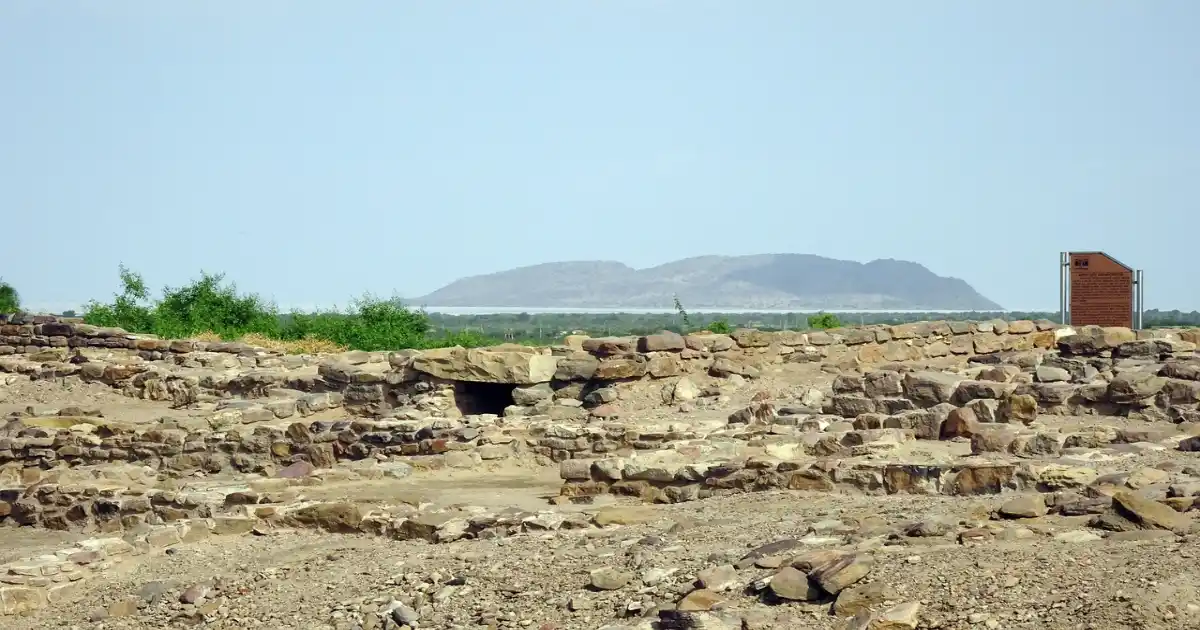It is an article that takes the reader on a journey to discover the ancient city of Dholavira and the civilization that once thrived there. Located in the northwest region of India, Dholavira is one of the largest and most well-preserved sites of the Harappan civilization, a Bronze Age culture that flourished in the Indus Valley around 2600-1900 BCE. The book provides an in-depth exploration of Dholavira, from its history and significance to the artifacts and architecture that provide insight into the daily life of the Harappans. The book also investigates the mystery of the disappearance of the Harappan civilization, discussing the theories that have been put forward to explain the decline of this once-great civilization. Additionally, the book touches on the impact of the Harappan civilization on modern Indian culture and the preservation of the Dholavira site for future generations. Overall, “Dholavira: Tracing the Footsteps of an Enigmatic Civilization” offers readers a comprehensive and fascinating look at this ancient city and its significance to Indian history and culture.
Chapter 1: Setting the Stage – Discovering Dholavira and its History
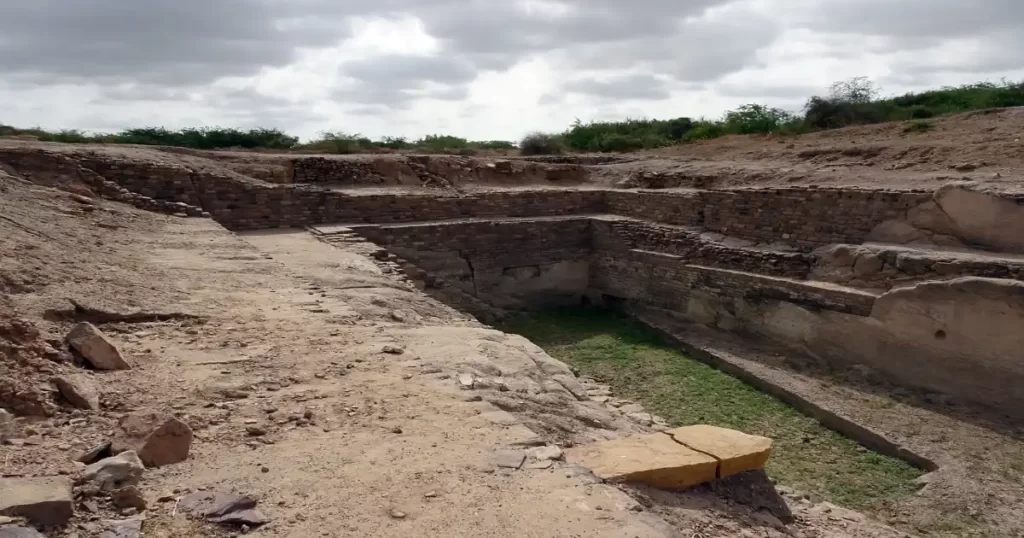
Welcome to the fascinating world of Dholavira! In this chapter, we will set the stage by delving into the history and significance of this ancient city, located in the Kutch region of Gujarat, India.
Dholavira is believed to have been built around 2600 BCE and was part of the Harappan civilization, also known as the Indus Valley civilization. At its height, Dholavira was a bustling metropolis, with a population of approximately 20,000 people. Its strategic location between two major rivers, the Rann of Kutch and the Arabian Sea, made it an important center for trade and commerce.
The first archaeological excavations at Dholavira were carried out in 1967 by the Archaeological Survey of India (ASI). Since then, several excavations have been conducted, revealing a wealth of information about the city and its inhabitants. The site covers an area of over 100 hectares and is divided into two parts – the Citadel and the Lower City.
The Citadel, located on a raised platform, was the administrative and religious center of the city. It contained a series of large buildings, including a granary, a palace, and a large bathhouse. The Lower City was a residential area, with houses arranged in a grid pattern.
The Harappan civilization, of which Dholavira was a part, was one of the most advanced of its time, with a system of writing, well-planned cities, and a sophisticated drainage system. The Harappans were skilled at metallurgy, and their artifacts include copper and bronze tools, pottery, and jewelry.
Despite its many accomplishments, the Harappan civilization declined and disappeared around 1900 BCE. The reasons for this decline are still not fully understood, although theories include environmental factors such as climate change and drought, as well as invasion and conflict.
Today, Dholavira stands as a testament to the ingenuity and creativity of the Harappan civilization. Its well-preserved structures and artifacts offer a glimpse into the daily life of the people who lived there thousands of years ago. In recognition of its cultural and historical significance, Dholavira has declared a UNESCO World Heritage Site in 2021.
As you embark on your journey to discover Dholavira, keep in mind the rich history and cultural heritage that this ancient city represents. The next chapters will take you on a tour of the site, exploring its architecture, artifacts, and mysteries.
Chapter 2: Journey to the Past – Getting to Dholavira and Exploring the Site
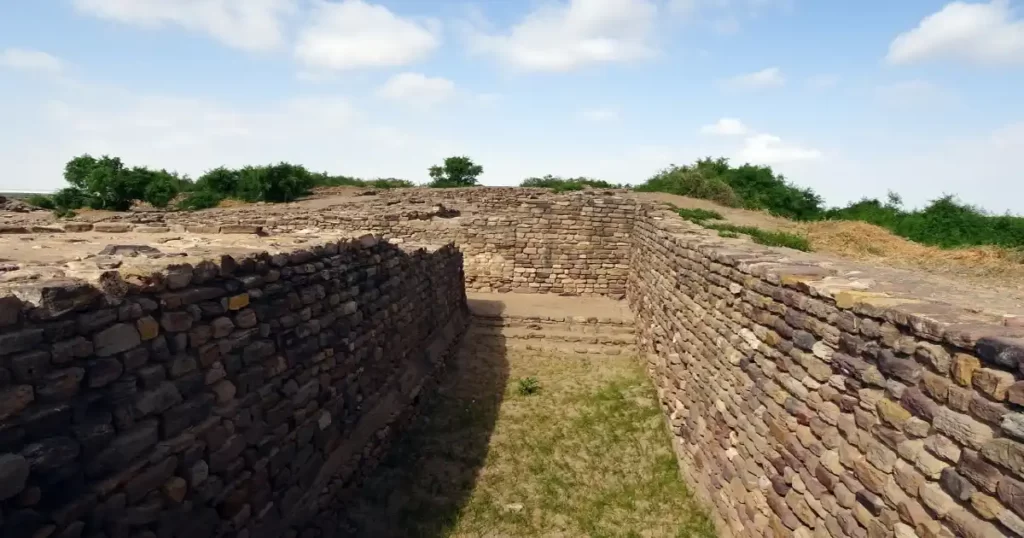
Congratulations! You’re on your way to exploring the fascinating site of Dholavira. In this chapter, we’ll guide you on how to get there and what to expect once you arrive.
Getting to Dholavira can be an adventure in itself. The nearest airport is in Bhuj, approximately 220 kilometers away, and the nearest railway station is in Gandhidham, which is around 210 kilometers away. From either of these places, you can hire a taxi or take a bus to reach Dholavira. The journey can take anywhere from four to six hours, depending on the mode of transportation and the traffic.
Once you arrive in Dholavira, you’ll need to purchase an entry ticket to access the site. The ticket includes a guide who will take you on a tour of the site and provide you with valuable insights and information about the history and significance of Dholavira.
The site is divided into two parts, the Citadel, and the Lower City, and it’s recommended that you visit both to get a comprehensive understanding of the city’s layout and organization. The Citadel is located on a raised platform and contains the administrative and religious center of the city, including a granary, a palace, and a large bathhouse. The Lower City was a residential area, with houses arranged in a grid pattern.
As you explore Dholavira, take note of the impressive architecture, including the intricate drainage system and the impressive ramparts that surround the city. Be sure to visit the impressive water reservoirs, including the world’s first known rainwater harvesting system, which demonstrates the Harappans’ advanced knowledge of engineering and water management.
The site also features a museum, where you can view a variety of artifacts, including pottery, jewelry, and tools. The museum provides an excellent opportunity to learn more about the Harappan civilization and the daily life of the people who lived in Dholavira thousands of years ago.
To make the most of your visit, it’s recommended that you wear comfortable clothing and shoes, as you’ll be doing a lot of walking. The site is open from sunrise to sunset, so plan to spend at least a few hours exploring.
As you journey to the past and explore the ancient city of Dholavira, keep in mind the rich history and cultural heritage that this site represents. It’s an opportunity to step back in time and learn more about the fascinating civilization that once thrived here.
Chapter 3: The Significance of Dholavira – Understanding the Importance of the Site to Indian History
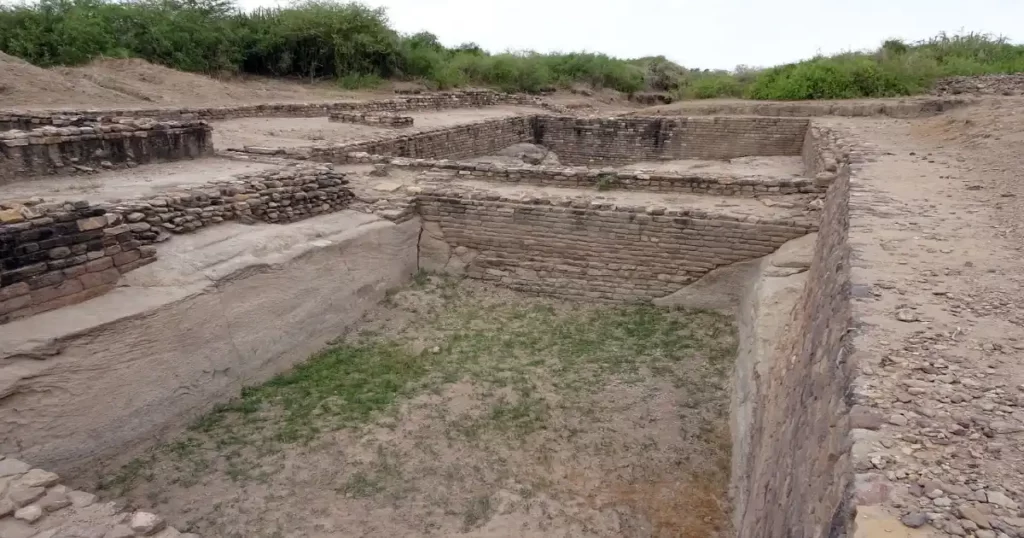
Dholavira is more than just an ancient site – it’s a window into the rich and diverse history of India. The site has great significance in understanding the culture and civilization of the Harappans, one of the oldest civilizations in the world. In this chapter, we’ll explore the importance of Dholavira in Indian history and culture.
Dholavira is a UNESCO World Heritage site and is considered one of the most important archaeological sites in India. It was discovered in 1967 by archaeologist Jagat Pati Joshi, and since then, numerous excavations have been carried out to uncover the secrets of this ancient city. The site’s location in the Rann of Kutch desert has helped preserve many of its features, making it an invaluable resource for researchers and historians.
One of the main reasons why Dholavira is significant is that it provides insight into the Harappan civilization. The Harappans were one of the earliest urban civilizations in the world, and their culture and way of life have fascinated researchers and historians for years. Dholavira provides a unique opportunity to understand the organization, planning, and technology that the Harappans used to build and sustain their cities.
The site also highlights the significance of water management and conservation in the Harappan civilization. The city’s elaborate system of reservoirs, dams and drainage channels is a testament to the Harappans’ understanding of water management and conservation. The use of rainwater harvesting and groundwater recharge techniques was a vital aspect of the city’s sustainability and is still relevant today.
Dholavira’s significance also lies in its unique urban planning and architecture. The city was divided into two parts, the Citadel, and the Lower City, and each area had its own purpose and function. The Citadel housed the city’s administrative and religious center, while the Lower City was the residential area. The use of a grid pattern for the houses and the impressive ramparts that surrounded the city demonstrates the Harappans’ advanced knowledge of urban planning and architecture.
Finally, Dholavira is significant in its contribution to the cultural heritage of India. The site’s artifacts and structures provide insight into the daily life, customs, and beliefs of the Harappans. The city’s sophisticated pottery, jewelry, and tool-making techniques demonstrate their artistic skills and the sophistication of their crafts.
Chapter 4: Life in Ancient Dholavira – Learning About the Culture and Society of the Harappan Civilization
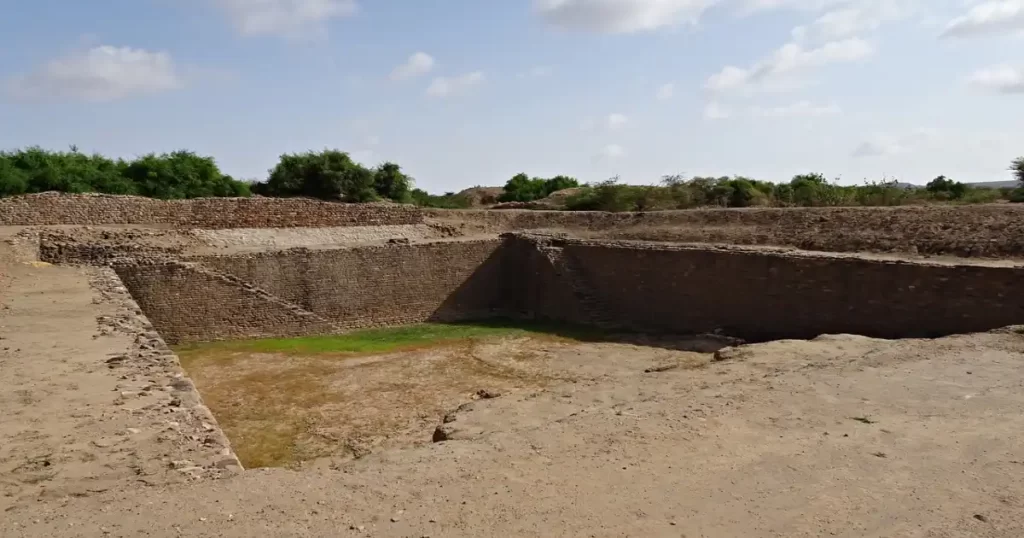
Dholavira, the ancient city of the Harappan civilization, was a bustling center of trade, art, and innovation. In this chapter, we’ll take a closer look at the culture and society of the Harappans and explore what life was like in ancient Dholavira.
The Harappan civilization was one of the most advanced civilizations of its time, and Dholavira was one of its largest and most prominent cities. The city was home to a thriving community of traders, artisans, and farmers. The Harappans were known for their impressive crafts, including pottery, jewelry, and textiles, which were traded throughout the region.
One of the unique features of Dholavira was its water management system, which was essential to the city’s survival. The city had a complex system of reservoirs, dams, and drainage channels, which allowed the Harappans to collect and store water during the monsoon season. The use of rainwater harvesting and groundwater recharge techniques ensured that the city had a constant supply of water, which was used for drinking, irrigation, and other daily needs.
The Harappans were a highly organized and structured society, with a clear hierarchy of power and authority. The city was divided into two parts, the Citadel and the Lower City, each with its own purpose and function. The Citadel was the administrative and religious center of the city, while the Lower City was the residential area.
The Harappans had a rich and diverse culture, with a unique style of art and architecture. The city’s impressive ramparts and buildings were constructed using a unique technique of stone masonry, which was an important aspect of their architecture. The Harappans were also known for their intricate pottery, jewelry, and textiles, which were highly sought after in the region.
Religion played an important role in Harappan society, and Dholavira was home to several temples and shrines. The city’s main temple, located in the Citadel, was dedicated to the goddess of water and fertility. The temple was a place of worship and also served as an administrative center for the city.
Chapter 5: The Architecture of Dholavira – Discovering the Engineering Marvels of the City

Dholavira, located in the Kutch district of Gujarat, India, is one of the five largest Harappan sites in the Indian subcontinent. The site dates back to the 3rd millennium BCE, making it one of the oldest and most fascinating cities of the ancient world. One of the most striking features of Dholavira is its well-planned and sophisticated architecture, which reflects the remarkable engineering skills of the Harappan civilization.
The city of Dholavira was built with a unique layout, comprising three distinct areas: the Citadel, the Middle Town, and the Lower Town. The Citadel is the largest and most complex of the three areas and is located at the center of the city. The Citadel covers an area of about 13 hectares and is surrounded by massive stone walls, which are as high as 18 meters in some places. The walls are made of large, well-carved sandstone blocks and are reinforced with bastions and towers.
The main entrance to the Citadel is through the city gate, which is one of the most impressive structures in Dholavira. The gate is made of two massive sandstone blocks, each weighing several tons, and is flanked by two large towers. The gate is so well-engineered that it still stands strong after more than 4,000 years.
Inside the Citadel, there are several impressive structures, including the large circular reservoir, the public baths, and the Great Hall. The circular reservoir, also known as the “water fort,” is a massive tank built with finely dressed stone blocks. The tank is divided into three parts, each with its own inlet and outlet channels. The reservoir was used for storing water for the city’s inhabitants during the dry season.
The public baths in Dholavira are among the best-preserved structures of their kind in the ancient world. The baths are located in the eastern part of the Citadel and consist of a large rectangular tank with steps leading down to the water level. The tank is surrounded by changing rooms, which were used by the bathers to change their clothes.
The Great Hall in Dholavira is one of the most impressive structures in the Citadel. The hall is a large rectangular building with a series of pillars supporting the roof. The hall was probably used for public gatherings, meetings, and other social events.
Moving to the Middle Town, we can see the residential areas of Dholavira. The Middle Town is laid out in a grid pattern, with streets running in a north-south and east-west direction. The houses in the Middle Town are made of mud bricks and are of various sizes, indicating a social hierarchy among the inhabitants.
The Lower Town is the largest of the three areas and is located on the eastern side of the city. The Lower Town is a densely populated area with narrow streets and small houses made of mud bricks. The Lower Town was probably the commercial and industrial hub of the city, where traders and craftsmen carried out their business.
One of the most remarkable features of Dholavira’s architecture is its sophisticated water management system. The city’s water supply came from two seasonal streams, the Mansar and Manhar, which flow through the city. The Harappans built a series of dams and canals to divert the water from the streams and distribute it throughout the city.
The dams and canals in Dholavira are an engineering marvel. The canals are lined with finely dressed stone blocks and are designed to maintain a constant flow of water. The Harappans also built several large reservoirs to store water during the dry season.
Chapter 6: The Artifacts of Dholavira – Examining the Tools, Pottery, and Ornaments of the Harappans

The artifacts found in Dholavira provide valuable insights into the daily life, culture, and technology of the Harappan civilization. The city of Dholavira is one of the most important archaeological sites in India, and the artifacts found here have greatly contributed to our understanding of the ancient Harappan civilization.
One of the most impressive artifacts found in Dholavira is the range of tools used by the Harappans. The Harappans were skilled craftsmen, and they used a variety of tools to create their artifacts. The tools found in Dholavira include stone hammers, chisels, blades, and drills. The tools were made of high-quality materials such as basalt, chert, and flint, and were often highly polished.
Pottery is another important artifact found in Dholavira. The Harappans were skilled potters, and they produced a wide range of pottery items, including bowls, jars, and vases. The pottery found in Dholavira is characterized by its fine craftsmanship and intricate designs. The pottery was made of clay and was often decorated with geometric patterns, animal motifs, and other designs.
One of the most interesting artifacts found in Dholavira is the “signboard” discovered in the citadel. The signboard is made of steatite and is inscribed with ten letters of the Harappan script. The script has not yet been deciphered, and the meaning of the inscription is still a mystery. The signboard is one of the few examples of Harappan writing found in India.
Another interesting artifact found in Dholavira is the jewelry and ornaments worn by the Harappans. The Harappans were skilled metalworkers, and they produced a wide range of ornaments, including necklaces, bracelets, earrings, and anklets. The ornaments were made of gold, silver, copper, and other metals, and were often decorated with precious stones and beads.
One of the most striking examples of Harappan jewelry found in Dholavira is the gold bangle, which was discovered in the lower town. The bangle is made of pure gold and is highly polished. The bangle is decorated with intricate designs, including images of animals and birds.
The Harappans were also skilled in the art of bead-making, and they produced a wide range of beads, including glass beads, stone beads, and shell beads. The beads were often used to make necklaces and other ornaments and were highly prized for their beauty and craftsmanship.
In addition to tools, pottery, and ornaments, Dholavira has also yielded a range of other artifacts, including seals, weights, and measures. The Harappans used seals to mark their property and goods, and the seals found in Dholavira are highly decorated and often depict animals and other motifs.
Overall, the artifacts found in Dholavira provide a fascinating glimpse into the daily life and culture of the Harappan civilization. The tools, pottery, and ornaments produced by the Harappans were highly skilled and often highly decorated, reflecting the importance that the Harappans placed on art, craftsmanship, and beauty. The artifacts found in Dholavira have greatly contributed to our understanding of the Harappan civilization, and continue to be studied and admired by archaeologists and historians alike.
Chapter 7: The Mystery of the Disappearance – Investigating the Causes of the Decline of Dholavira

Dholavira was a flourishing city of the Harappan civilization, with a population of over 20,000 people at its peak. However, the city declined and eventually disappeared, leaving behind a mystery that has intrigued archaeologists and historians for decades. In this chapter, we will investigate the causes of the decline of Dholavira and the mysterious disappearance of the city.
One of the theories regarding the decline of Dholavira is related to the changing patterns of the river systems. The Harappan civilization was heavily dependent on the Indus River and its tributaries for irrigation and agriculture. However, around 1900 BCE, the river systems began to shift, leading to a decline in the agricultural productivity of the region. This, in turn, may have contributed to the decline of Dholavira.
Another theory suggests that climate change played a role in the decline of Dholavira. It is believed that the region underwent a period of aridification, which led to a decline in agricultural productivity and the depletion of natural resources. The changing climate may have also contributed to the migration of people away from Dholavira and the surrounding region.
The decline of Dholavira may have also been influenced by political and social factors. It is believed that the Harappan civilization was a highly centralized society, with a strong hierarchical structure. The decline of the central authority may have led to the fragmentation of society and the weakening of the city-states. This, in turn, may have contributed to the decline of Dholavira and other Harappan cities.
Theories of natural disasters, such as earthquakes or floods, have also been proposed as possible causes of the decline of Dholavira. However, there is little evidence to support these claims, and they remain largely speculative.
In addition to these theories, there is also the possibility that a combination of these factors contributed to the decline of Dholavira. It is likely that a complex interplay of environmental, political, and social factors led to the decline of the city.
Despite the many theories surrounding the decline of Dholavira, the truth remains elusive. The city disappeared without leaving behind any written records, and the archaeological evidence is often fragmentary and inconclusive. The exact causes of the decline of Dholavira may never be fully understood.
However, the legacy of Dholavira lives on, and the city remains an important part of the cultural heritage of India. The artifacts and architectural remains of the city provide valuable insights into the daily life, culture, and technology of the Harappan civilization. The mystery of the disappearance of Dholavira only adds to the intrigue and fascination surrounding this ancient city, ensuring that it will continue to be studied and admired for generations to come.
Chapter 8: Beyond Dholavira – Exploring Other nearby Historical Sites in the Region
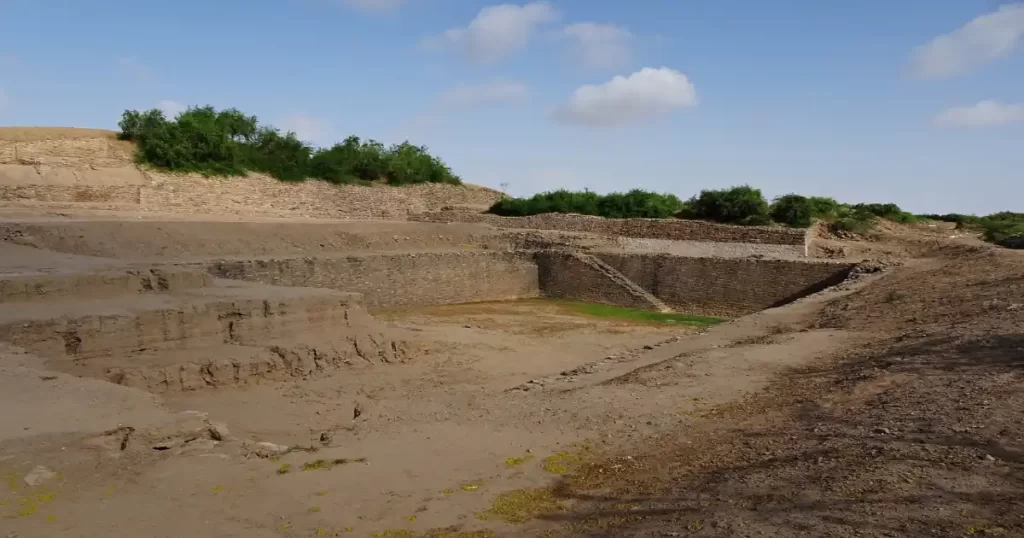
Dholavira is not the only historical site in the region that offers valuable insights into the ancient history and culture of India. In this chapter, we will explore other nearby historical sites that are worth visiting to gain a deeper understanding of the region’s rich cultural heritage.
One such site is Lothal, located about 80 kilometers from Dholavira. Lothal was an important port city of the Harappan civilization and played a vital role in the trade network of the ancient world. The city was strategically located on the Gulf of Khambhat and served as a hub for the trade of goods such as beads, semi-precious stones, ivory, and shells. The city’s dockyard, which was connected to the river by a canal, is an engineering marvel that demonstrates the advanced technical knowledge of the Harappan civilization.
Another nearby historical site is Rangpur, located about 130 kilometers from Dholavira. Rangpur was a significant city during the medieval period, with a rich cultural and architectural heritage. The city is home to several temples and palaces, including the famous Rangpur Palace, which is a beautiful example of Indo-Saracenic architecture. The palace was built in the 19th century and was once the residence of the local king.
Yet another nearby historical site is Bhuj, located about 220 kilometers from Dholavira. Bhuj is a vibrant city that is known for its rich cultural heritage, colorful bazaars, and stunning architecture. The city is home to several historical monuments and museums, including the Pragmahal Palace, which is a beautiful example of Italian Gothic architecture. The palace was built in the 19th century and was once the residence of the local ruler.
These are just a few examples of the many historical sites that can be explored in the region surrounding Dholavira. Each site offers a unique glimpse into the rich cultural heritage of India, and visiting them can help deepen our understanding of the history and culture of the region.
In addition to historical sites, the region is also home to several natural wonders that are worth exploring. The Rann of Kutch, for example, is a vast salt desert that is located near Dholavira. The desert is home to a diverse array of wildlife, including flamingos, wild asses, and several species of migratory birds. Exploring the Rann of Kutch is a unique and unforgettable experience that offers a glimpse into the natural beauty and biodiversity of the region.
Chapter 9: The Impact of Dholavira – Assessing the Influence of the Harappan Civilization on Modern Indian Culture
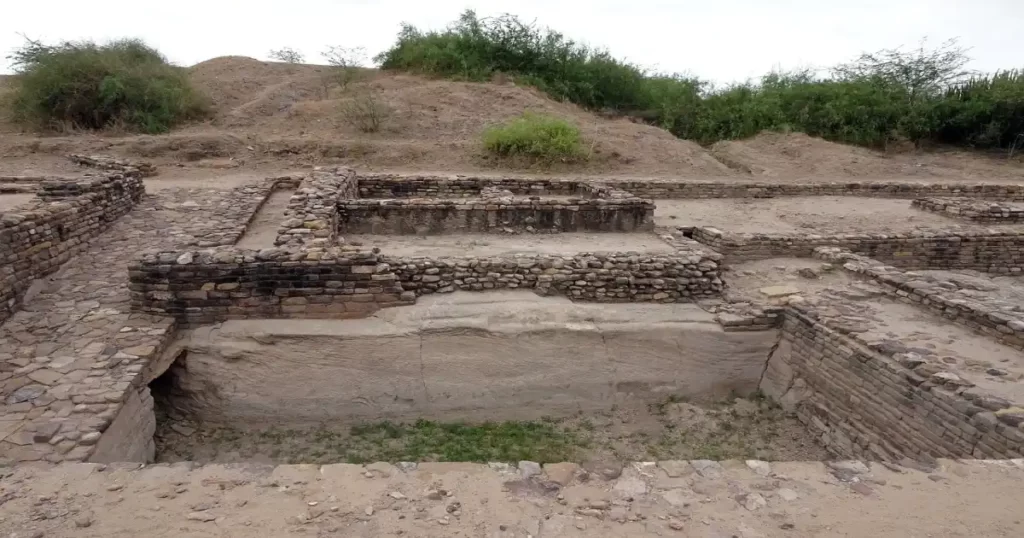
Dholavira is not just a relic of the ancient past; it has had a lasting impact on the culture and society of India. The Harappan civilization, of which Dholavira was a significant part, was one of the world’s earliest urban societies and had a profound influence on the development of Indian culture.
One of the most significant ways in which the Harappan civilization has influenced modern Indian culture is through its art and architecture. The intricate carvings and sculptures found at sites like Dholavira and Mohenjo-Daro have inspired generations of Indian artists and artisans. The use of geometric patterns and motifs, such as the swastika, in Harappan art has become a staple of Indian design, seen in everything from textiles to jewelry.
The Harappan civilization also had a profound impact on the Indian language and literature. The Indus script, which is still not fully deciphered, is believed to be one of the earliest forms of writing in India. The language used in the script is thought to have influenced the development of several modern Indian languages, including Sanskrit and Hindi.
The Harappan civilization also had a significant impact on the development of Indian society and culture. The system of urban planning and sanitation that was developed in Harappan cities, including Dholavira, has had a lasting impact on modern Indian cities. The idea of creating planned cities with sophisticated drainage and waste disposal systems is still prevalent in modern Indian city planning.
Furthermore, the Harappan civilization’s advanced knowledge of metallurgy, agriculture, and trade has had a significant impact on the development of the Indian economy and industry. The use of copper, bronze and other metals in Harappan artifacts and tools inspired the development of India’s rich tradition of metalwork. The Harappans’ knowledge of agriculture, including their use of crop rotation and irrigation, helped lay the foundation for modern Indian agriculture. The sophisticated trade networks that the Harappan civilization established with other parts of the ancient world helped shape the early Indian economy.
Chapter 10: The Future of Dholavira – Discussing the Preservation and Conservation of the Site for Future Generations.
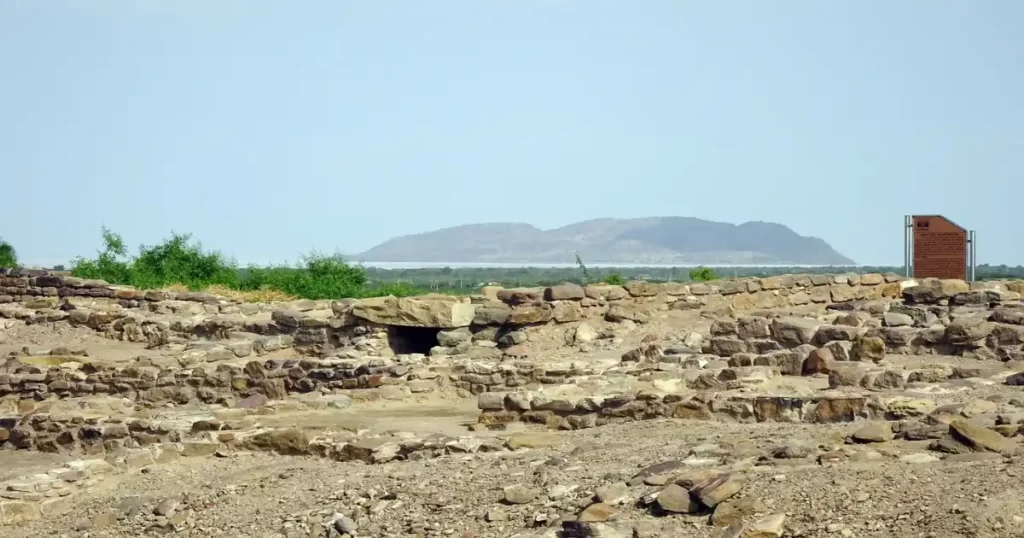
As one of the most significant archaeological sites in India, Dholavira must be preserved and conserved for future generations to appreciate and learn from. The site’s age, complexity, and cultural significance make it an invaluable resource for scholars, researchers, and visitors alike. In this chapter, we will discuss the future of Dholavira and the steps being taken to preserve and protect this unique site.
The first step in preserving Dholavira is to ensure that the site is properly maintained and protected. This involves a range of measures, from regular cleaning and maintenance of the site to the installation of protective barriers and fencing. The site must be kept in a stable condition to prevent damage from natural elements and human interference.
Another crucial aspect of preserving Dholavira is to promote responsible tourism. While it is essential to allow visitors to experience the site, it is equally important to ensure that they do not cause any damage or disturbance. Visitors should be informed about the importance of the site and the need to preserve it for future generations. Proper infrastructure, including visitor centers, information boards, and guided tours, can help to ensure that visitors have a positive and educational experience at Dholavira.
In addition to physical conservation, the preservation of Dholavira also requires ongoing research and documentation. Archaeologists and researchers must continue to study the site to deepen our understanding of the Harappan civilization and its significance. The documentation of the site, including maps, photographs, and records, is essential to ensure that the site’s history and significance are preserved for future generations.
Finally, the conservation of Dholavira also requires the support and involvement of the local community. The site is situated in a remote and rural area, and the local community must be involved in the conservation efforts to ensure their support and ownership of the project. Engaging with the local community through education and awareness programs can also help to build a sense of pride and ownership in the site, which can be a powerful tool in promoting its preservation.
How to reach Dholavira…..

Dholavira is located in the Kutch district of Gujarat in India. The nearest city is Bhuj, which is around 214 kilometers away from Dholavira. Here’s a brief guide on how to reach Dholavira:
By Air: The nearest airport to Dholavira is the Bhuj airport, which is well-connected to major cities in India. From the airport, you can hire a taxi or take a bus to reach Dholavira.
By Train: The nearest railway station to Dholavira is the Bhuj railway station, which is well-connected to major cities in India. From the railway station, you can hire a taxi or take a bus to reach Dholavira.
By Road: Dholavira is well-connected by road, and there are several buses and taxis available from Bhuj and other nearby cities. You can also drive to Dholavira from Bhuj, which takes around 4-5 hours.
It is important to note that the road to Dholavira is not well-maintained, and the journey can be bumpy and uncomfortable. It is advisable to hire a sturdy vehicle or take a bus. Also, it is recommended to plan your visit during the winter months (November to February) as the weather is pleasant and comfortable during this time.
Once you reach Dholavira, you can explore the site on foot or hire a local guide to learn more about the history and significance of this ancient city.
Conclusion
Dholavira is a remarkable testament to the ingenuity and creativity of the ancient Harappan civilization. The city’s intricate architecture, advanced water management systems, and sophisticated urban planning are evidence of a highly developed and organized society. Despite being abandoned more than 4,000 years ago, the ruins of Dholavira continue to fascinate and intrigue historians, archaeologists, and visitors alike.
Through the centuries, Dholavira has weathered numerous challenges and survived the test of time. It has faced natural disasters, invasions, and even the slow erosion of history’s sands, yet it remains an enigma, waiting to be explored and studied. It is a glimpse into the past, a window into the fascinating world of the Harappan civilization and its unique way of life.
As we trace the footsteps of this ancient civilization, we are reminded of the importance of understanding our past and the role it plays in shaping our present and future. Dholavira is not just a collection of ruins; it is a living legacy of a civilization that helped shape the world as we know it today.
In exploring the mysteries of Dholavira, we gain a deeper appreciation for the achievements of our ancestors and a greater understanding of our own place in the world. It is a journey that connects us with our past, present, and future, and reminds us of the enduring power of human ingenuity and creativity.
In preserving and protecting Dholavira for future generations, we honor the legacy of the Harappan civilization and ensure that their story is never lost to history. It is a responsibility we all share, and a reminder of our duty to safeguard the treasures of our past for the benefit of all. Dholavira is not just a site to be explored, but a living testament to the resilience and perseverance of the human spirit.

